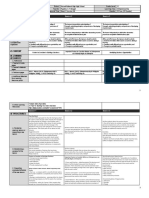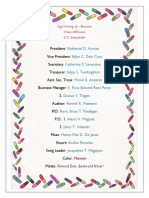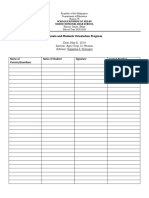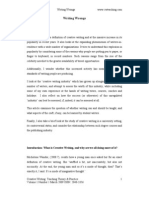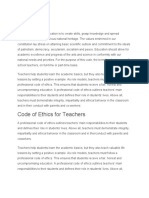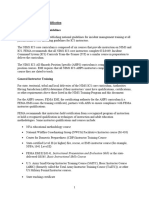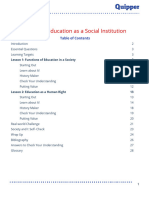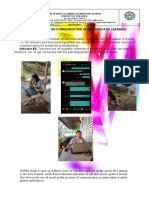0 ratings0% found this document useful (0 votes)
421 viewsCar DLL 3
Car DLL 3
Uploaded by
Rupelma Salazar PatnugotThe daily lesson log outlines a contemporary Philippine arts lesson for grade 12 students over 4 sessions. The objectives are to explain Filipino artists' roles and contributions to contemporary arts. Content includes significant artists from the students' region, including National Artists in music, dance, theater, visual arts and literature. Learning resources include PowerPoints and textbook pages on contemporary Philippine arts. Procedures involve reviewing past lessons, discussing National and GAMABA artists and their works, and having students select and discuss examples of cultural appropriation in traditional art forms.
Copyright:
© All Rights Reserved
Available Formats
Download as DOCX, PDF, TXT or read online from Scribd
Car DLL 3
Car DLL 3
Uploaded by
Rupelma Salazar Patnugot0 ratings0% found this document useful (0 votes)
421 views3 pagesThe daily lesson log outlines a contemporary Philippine arts lesson for grade 12 students over 4 sessions. The objectives are to explain Filipino artists' roles and contributions to contemporary arts. Content includes significant artists from the students' region, including National Artists in music, dance, theater, visual arts and literature. Learning resources include PowerPoints and textbook pages on contemporary Philippine arts. Procedures involve reviewing past lessons, discussing National and GAMABA artists and their works, and having students select and discuss examples of cultural appropriation in traditional art forms.
Original Description:
dll
Original Title
CAR DLL 3
Copyright
© © All Rights Reserved
Available Formats
DOCX, PDF, TXT or read online from Scribd
Share this document
Did you find this document useful?
Is this content inappropriate?
The daily lesson log outlines a contemporary Philippine arts lesson for grade 12 students over 4 sessions. The objectives are to explain Filipino artists' roles and contributions to contemporary arts. Content includes significant artists from the students' region, including National Artists in music, dance, theater, visual arts and literature. Learning resources include PowerPoints and textbook pages on contemporary Philippine arts. Procedures involve reviewing past lessons, discussing National and GAMABA artists and their works, and having students select and discuss examples of cultural appropriation in traditional art forms.
Copyright:
© All Rights Reserved
Available Formats
Download as DOCX, PDF, TXT or read online from Scribd
Download as docx, pdf, or txt
0 ratings0% found this document useful (0 votes)
421 views3 pagesCar DLL 3
Car DLL 3
Uploaded by
Rupelma Salazar PatnugotThe daily lesson log outlines a contemporary Philippine arts lesson for grade 12 students over 4 sessions. The objectives are to explain Filipino artists' roles and contributions to contemporary arts. Content includes significant artists from the students' region, including National Artists in music, dance, theater, visual arts and literature. Learning resources include PowerPoints and textbook pages on contemporary Philippine arts. Procedures involve reviewing past lessons, discussing National and GAMABA artists and their works, and having students select and discuss examples of cultural appropriation in traditional art forms.
Copyright:
© All Rights Reserved
Available Formats
Download as DOCX, PDF, TXT or read online from Scribd
Download as docx, pdf, or txt
You are on page 1of 3
SCHOOL Naisud National High School GRADE LEVEL Grade 12- GAS/ TVL
GRADES 1 TO 12 TEACHER Rupelma S. Patnugot LEARNING AREA Contemporary Philippine Arts from the Region
DAILY LESSON LOG TEACHING DATES AND TIME QUARTER First/ Week 3
SESSION 1 SESSION 2 SESSION 3 SESSION 4
I.OBJECTIVES Objectives must be met over the week and connected to the curriculum standards. To meet the objectives, necessary procedures must be followed and if needed,
additional lessons, exercises and remedial activities may be done for developing content knowledge and competencies. These are assessed using Formative
Assessment strategies. Valuing objectives support the learning of content and competencies and enable to find significance and joy in learning the lessons. Weekly
objectives shall be derived from the curriculum guides.
A.Content Standards Understanding of the significant roles of artists from the regions
B.Performance Standards Creates avenues to advocate the arts from the different regions
C.Learning Competencies/Objectives Explains Filipino artists’ roles and Explains Filipino artists’ roles and Explains Filipino artists’ roles and Explains Filipino artists’ roles and
Write the LC Code for each identify their contribution to identify their contribution to identify their contribution to identify their contribution to
contemporary arts. contemporary arts. (CAR11/12CAP- contemporary arts contemporary arts
(CAR11/12CAP-0c -e-5) 0c -e-5)
II.CONTENT Content is what the lesson is all about. It pertains to the subject matter that the teacher aims to teach. In the CG, the content can be tackled in a week or two.
B. CONTEMPORARY ARTS IN THE B. CONTEMPORARY ARTS IN THE Gawad sa Manlilikhang Bayan Gawad sa Manlilikhang Bayan
PHILIPPINES PHILIPPINES a. Folk architecture a. Folk architecture
Significant Contemporary artists Significant Contemporary artists b. Maritime transport b. Maritime transport
from the regions (emphasizing from the regions (emphasizing the c. Weaving c. Weaving
the region where the school is region where the school is based) d. Carving d. Carving
based) 1.National Artists e. Performing arts e. Performing arts
1. National Artists a. Music f. Literature f. Literature
a. Music b. Dance g. Graphic and plastic arts g. Graphic and plastic arts
b. Dance c. Theater h. Ornament h. Ornament
c. Theater d. Visual Arts i. Textile or fiber art i. Textile or fiber art
d. Visual Arts e. Literature j. Pottery j. Pottery
e. Literature f. Film and Broadcast Arts
f. Film and Broadcast Arts g. Architecture, Design and Allied
g. Architecture, Design and Arts
Allied Arts
III.LEARNING RESOURCES List the materials to be used in different days. Varied sources of materials sustain children’s interest in the lesson and in learning. Ensure that there is a mix of
concrete and manipulative materials as well as paper- based materials. Hands- on learning promotes concept development.
A.References
1.Teacher’s Guides/Pages
2.Learner’s Materials Pages
3.Textbook Pages
4.Additional Materials from Learning
Resources (LR) portal
B.Other Learning Resources Powerpoint downloaded from Powerpoint downloaded from Powerpoint downloaded from Powerpoint downloaded from
drive.google.com; Contemporary drive.google.com; coloring drive.google.com; Contemporary drive.google.com; Contemporary
Philippine Arts from the Regions materials; Contemporary Philippine Philippine Arts from the Regions Philippine Arts from the Regions by
by Datuin, F. M. et. al pp. 65- 73 Arts from the Regions by Datuin, F. by Datuin, F. M. et. al pp. 56- 64 Datuin, F. M. et. al pp. 56- 64
M. et. al pp. 65- 73
IV.PROCEDURES These steps should be done across the week. Spread out the activities appropriately so that students will learn well. Always be guided by demonstration of learning
by the students which you can infer from formative assessment activities. Sustain learning systematically by providing students with multiple ways to learn new
things, practice their learning processes, and draw conclusions about what they learned in relation to their life experiences and previous knowledge, indicate the
time allotment for each step.
A.Reviewing previous lesson or The teacher reviews the learners Review the class about National Review the class about National Review about GAMABA awardees
presenting the new lesson about the past lesson. Artist Awardees that were discussed Artist Award. that were discussed yesterday.
last meeting.
B.Establishing a purpose for the lesson Ask the learners about what they
know about an artist.
C.Presenting examples/instances of Using coconut leaves, create an
the new lesson artwork that can be done in thirty
minutes.
D.Discussing new concepts and Discuss about the National Artists Discuss about the National Artists Discuss about GAMABA. Have a continuation on discussing
practicing new skills #1 for Music, Dance, Theater, Visual for Literature, Film and Broadcast GAMABA.
Arts. Arts, and Architecture, Design and
Allied Arts
E.Discussing new concepts and Discuss about controversies behind Discuss about the awardees of Discuss about the issues related to
practicing new skills #2 the award. GAMABA. GAMABA awards.
F.Developing mastery Ask: The learners’ activity:
(Leads to formative assessment)
What should the award- giving body Select a form in which any of the
do to protect its integrity? Manlilikha ng Bayan practice. Give
specific examples of how that form
has undergone appropriation or
transformation--- both internally
or by the community itself, and
externally by outside forces, or
both--- to create new meanings
and appeal to different publics.
G.Finding practical/applications of Ask: Ask: Ask: Ask:
concepts and skills in daily living
How the National Artists help you How can the award- giving body How GAMABA influences you to How GAMABA influences you to
appreciate more the art we strengthen your belief that art is value the folk lifestyle? value the folk lifestyle.
have? important aspect in your life?
H. Making generalizations and Learners generalize about the Learners compare the contributions Learners compare the awardees. Learners summarize the topic
abstractions about the lesson concepts being discussed. of National Artists in our country. about GAMABA awards.
I.Evaluating Learning Let the learners choose a The learners will draw a The learners answer this question: Do:
National Artist Awardee and let representation of an ideal artist.
them list the traits of the artist What is the significance of Name one traditional art form in
they want to imitate. GAMABA? your community. Create a poster
to promote it. It can be on a
cartolina or you an digitally make
the poster with a computer.
Discuss your concept in class.
Share where you can plan to post
it.
J.Additional activities for application
or remediation
V.REMARKS Contemporary Philippine Arts from the Region is taken four times a week by the learners with one (1) hour per meeting.
VI.REFLECTION Reflect on your teaching and assess yourself as a teacher. Think about your students, progress this week. What works? What else needs to be done
to help the students learn? Identify what help your instructional supervisors can provide for you so when you meet them, you can ask relevant
questions.
A.No. of learners who earned 80% of
the formative assessment
B.No. of learners who require
additional activities to remediation
C.Did the remedial lessons work? No.
of learners who have caught up with
the lesson
D.No. of learners who continue to
require remediation
E.Which of my teaching strategies
worked well? Why did these work?
F.What difficulties did I encounter
which my principal or supervisor can
help me solve?
G.What innovation or localized
material did I use/discover which I
wish to share with other teachers?
You might also like
- DLL For Contemporary Philippine Arts From The RegionDocument3 pagesDLL For Contemporary Philippine Arts From The RegionMIMOYOU81% (68)
- CPAR DLL 2NDDocument2 pagesCPAR DLL 2NDFelyn DelaCruz - Dalino100% (18)
- DLL CPAR Week 1Document5 pagesDLL CPAR Week 1Rachel Edquid100% (10)
- DLL CPAR Week-2Document6 pagesDLL CPAR Week-2Rachel Edquid100% (6)
- DLL in CPARDocument3 pagesDLL in CPARVenus Estacio100% (6)
- Budget of work-CPARDocument4 pagesBudget of work-CPARaileen banaguas100% (3)
- I.Objectives: Contemporary Philippine Arts From The RegionDocument3 pagesI.Objectives: Contemporary Philippine Arts From The Regionlomboy elemschool80% (5)
- Cpar DLL 3RDDocument2 pagesCpar DLL 3RDFelyn DelaCruz - Dalino100% (2)
- Week 1 & 2Document17 pagesWeek 1 & 2Jayson Saguid Sibobo100% (3)
- DLL in Contemporary ArtsDocument16 pagesDLL in Contemporary ArtsRa Chel100% (8)
- Quiz in PhiloDocument1 pageQuiz in PhiloRupelma Salazar PatnugotNo ratings yet
- Quiz in PhiloDocument1 pageQuiz in PhiloRupelma Salazar PatnugotNo ratings yet
- 4th WeekDocument3 pages4th WeekMaricar Narag SalvaNo ratings yet
- Dll-Cpar 10-13Document3 pagesDll-Cpar 10-13SantiagoMateoGonzalesQuilal-lan100% (6)
- Cpar 12 DLLDocument3 pagesCpar 12 DLLDario Dela Cruz100% (6)
- Car DLL 1Document4 pagesCar DLL 1Rupelma Salazar Patnugot100% (2)
- I.Objectives: Contemporary Philippine Arts From The RegionDocument4 pagesI.Objectives: Contemporary Philippine Arts From The Regionlomboy elemschool100% (1)
- Contemp 4Document4 pagesContemp 4Dario Dela CruzNo ratings yet
- DLL Week 3 ContempoDocument2 pagesDLL Week 3 ContempoLovely Mejasco100% (1)
- DLL For Contemporary Philippine Arts From The RegionDocument3 pagesDLL For Contemporary Philippine Arts From The RegionNhed'z Abd ArolaNo ratings yet
- DLL Dec. 2-6Document3 pagesDLL Dec. 2-6Cristel Anne A. LlamadorNo ratings yet
- CAR DLL July 3 - 7, 2017 Grade 12Document3 pagesCAR DLL July 3 - 7, 2017 Grade 12Darwin Mateo Santos100% (1)
- CAR DLL July 3 - 7, 2017 Grade 12Document3 pagesCAR DLL July 3 - 7, 2017 Grade 12shielo floresNo ratings yet
- DLL For Contemporary Philippine Arts From The RegionDocument2 pagesDLL For Contemporary Philippine Arts From The RegionGheyDelaCueva100% (1)
- Cot 2 (01-24-2020)Document6 pagesCot 2 (01-24-2020)Mari ClaireNo ratings yet
- CA - 6TH WeekDocument15 pagesCA - 6TH WeekLeah Jean Villegas100% (1)
- Cpar-Dll Apr-1-5-2019Document4 pagesCpar-Dll Apr-1-5-2019Glaitootxs Dela RosaNo ratings yet
- Cpar DLL - Week - 3Document5 pagesCpar DLL - Week - 3Charie Dhiclihon100% (3)
- DLL-CPAR - October 3-6Document4 pagesDLL-CPAR - October 3-6SantiagoMateoGonzalesQuilal-lan100% (2)
- Cpar Q2 DLL Week 4Document3 pagesCpar Q2 DLL Week 4Jhun Gatasi0% (1)
- Cpar Q2 DLL Week 7Document4 pagesCpar Q2 DLL Week 7Jhun GatasiNo ratings yet
- Cpar Q2 DLL Week 5Document4 pagesCpar Q2 DLL Week 5Jhun Gatasi50% (2)
- Contemporary-2 2Document3 pagesContemporary-2 2MlynNo ratings yet
- CPAR Week 2.1Document2 pagesCPAR Week 2.1Totep ReyesNo ratings yet
- Cpar DLL - Week 4Document5 pagesCpar DLL - Week 4Charie Dhiclihon100% (2)
- Contemporary Week 3 DLLDocument3 pagesContemporary Week 3 DLLMae Jane Aguilar100% (1)
- Cpar Week 3Document4 pagesCpar Week 3Renz Dominic Gonzales100% (2)
- Contemporary Week 5 DLLDocument4 pagesContemporary Week 5 DLLMae Jane Aguilar100% (3)
- Contemporary Art DLL Q2 WEEK 1Document2 pagesContemporary Art DLL Q2 WEEK 1Eduardo Jr OcañaNo ratings yet
- DLL in Contemporary ArtsDocument4 pagesDLL in Contemporary ArtsArdelyn L. GlodobeNo ratings yet
- CPAR DLL 2nd WEEKDocument4 pagesCPAR DLL 2nd WEEKCharie Dhiclihon100% (3)
- DLL WK 3 Contemporary Philippine Arts From The RegionsDocument4 pagesDLL WK 3 Contemporary Philippine Arts From The Regionsrosa4rosata186% (7)
- Cpar DLL Week 1Document6 pagesCpar DLL Week 1Pontejos Princess Dianne G.No ratings yet
- Contemporary Philippine Arts From The RegionsDocument3 pagesContemporary Philippine Arts From The RegionsJena-Lyn100% (12)
- DLL Cpar Week 7Document6 pagesDLL Cpar Week 7Marlowe Marquez67% (3)
- Cpar W1Document3 pagesCpar W1Lina Soriano100% (1)
- Contemporary Week 2 DLLDocument3 pagesContemporary Week 2 DLLMae Jane Aguilar0% (1)
- 2nd Quarter Contemporary-Philippine-Arts-from-the-RegionsDocument3 pages2nd Quarter Contemporary-Philippine-Arts-from-the-RegionsMaria Macel100% (3)
- Contemporary Week 5 DLL PDF FreeDocument4 pagesContemporary Week 5 DLL PDF Freemaychelle mae camanzoNo ratings yet
- DLL WK 3 Contemporary Philippine Arts From The RegionsDocument3 pagesDLL WK 3 Contemporary Philippine Arts From The RegionsEcond Tonyth Elyjan100% (11)
- TOS CPAR MidtermDocument1 pageTOS CPAR MidtermRubs AD100% (3)
- Cpar - DLL - Week 6Document2 pagesCpar - DLL - Week 6Eduardo Jr Ocaña100% (1)
- DLL CparDocument3 pagesDLL CparVenus EstacioNo ratings yet
- Learning Plan-Con ArtsDocument17 pagesLearning Plan-Con Artsaileen alegadoNo ratings yet
- CAR DLL WK 1Document3 pagesCAR DLL WK 1joana torculasNo ratings yet
- 1CPARDocument3 pages1CPARDario Dela CruzNo ratings yet
- Lesson Plan-CparDocument2 pagesLesson Plan-CparGeriza Joy Rico33% (3)
- Contemporary Week 1 DLLDocument5 pagesContemporary Week 1 DLLMae Jane Aguilar100% (4)
- DLL Nov. 25-29Document3 pagesDLL Nov. 25-29Cristel Anne A. Llamador100% (1)
- DLL1Document3 pagesDLL1melany r. malvarosaNo ratings yet
- Cpar WK4 Feb20 242023Document4 pagesCpar WK4 Feb20 242023melvinburbos938No ratings yet
- Cpar WK5 Feb27 To Mar.32023Document4 pagesCpar WK5 Feb27 To Mar.32023melvinburbos938No ratings yet
- Entrep DLL 2nd WeekDocument8 pagesEntrep DLL 2nd WeekRupelma Salazar Patnugot100% (1)
- Part Iii: Summary of Ratings For Discussion: Naisud National High SchoolDocument3 pagesPart Iii: Summary of Ratings For Discussion: Naisud National High SchoolRupelma Salazar PatnugotNo ratings yet
- Methods of PhilosophizingDocument14 pagesMethods of PhilosophizingRupelma Salazar PatnugotNo ratings yet
- CPAR2Document15 pagesCPAR2Rupelma Salazar Patnugot0% (1)
- Human Person?: What Is ADocument19 pagesHuman Person?: What Is ARupelma Salazar PatnugotNo ratings yet
- Theology Agnosticism Polytheism Theism E. Worldview F. Monism G. Monotheism H. Atheism I. Religion J. SpiritualityDocument5 pagesTheology Agnosticism Polytheism Theism E. Worldview F. Monism G. Monotheism H. Atheism I. Religion J. SpiritualityRupelma Salazar PatnugotNo ratings yet
- Methods of PhilosophizingDocument23 pagesMethods of PhilosophizingMichelle Berme86% (21)
- Actual Work Immersion at Seri Culture Center Sitio Agbaliw, San Jose, Ibajay, AklanDocument11 pagesActual Work Immersion at Seri Culture Center Sitio Agbaliw, San Jose, Ibajay, AklanRupelma Salazar PatnugotNo ratings yet
- Fact vs. Opinion: An Interactive ExerciseDocument31 pagesFact vs. Opinion: An Interactive ExerciseRupelma Salazar PatnugotNo ratings yet
- UCSP LP Week 20Document3 pagesUCSP LP Week 20Rupelma Salazar PatnugotNo ratings yet
- Logical Fallacies II: Fallacies of Insufficient EvidenceDocument38 pagesLogical Fallacies II: Fallacies of Insufficient EvidenceRupelma Salazar PatnugotNo ratings yet
- Agri OfficersDocument1 pageAgri OfficersRupelma Salazar PatnugotNo ratings yet
- EssayDocument1 pageEssayRupelma Salazar PatnugotNo ratings yet
- Almighty Father in HeavenDocument3 pagesAlmighty Father in HeavenRupelma Salazar PatnugotNo ratings yet
- Car DLL 1Document4 pagesCar DLL 1Rupelma Salazar Patnugot100% (2)
- PTA Orientation - AttendanceDocument1 pagePTA Orientation - AttendanceRupelma Salazar PatnugotNo ratings yet
- The Story of Miracle Behind The Ati-Atihan FestivalDocument1 pageThe Story of Miracle Behind The Ati-Atihan FestivalRupelma Salazar PatnugotNo ratings yet
- QuescussionDocument1 pageQuescussionRupelma Salazar PatnugotNo ratings yet
- Edu 412 Disciplinary Literacy Lesson SegmentDocument20 pagesEdu 412 Disciplinary Literacy Lesson Segmentapi-667056132No ratings yet
- OK Sa DEPED ACTION PLAN 2023Document1 pageOK Sa DEPED ACTION PLAN 2023Norfaida IdjasNo ratings yet
- Training Design-Proposal For A Training in Action ResearchDocument3 pagesTraining Design-Proposal For A Training in Action ResearchRex Martinez89% (9)
- PDSM Assignment BriefDocument6 pagesPDSM Assignment BriefRobert DavisNo ratings yet
- Juliet England - Writing WrongsDocument14 pagesJuliet England - Writing WrongsalphmlkNo ratings yet
- Smart Industry Readiness Index Siri Assessor Course GuideDocument3 pagesSmart Industry Readiness Index Siri Assessor Course Guideahmedtarek0094No ratings yet
- (Fri) SWOT AnalysisDocument2 pages(Fri) SWOT AnalysisMichelle Anne Legaspi Bawar0% (1)
- Dalirig National High School: Individual ScheduleDocument5 pagesDalirig National High School: Individual ScheduleWendy BalaodNo ratings yet
- Impact of Students Vocabulary Level To TDocument15 pagesImpact of Students Vocabulary Level To TDougNo ratings yet
- Formal Report Project-112 F08Document2 pagesFormal Report Project-112 F08dangerdog15No ratings yet
- Chapter 6.metacogntionDocument18 pagesChapter 6.metacogntionAlex FrançaNo ratings yet
- Clark Et Al 2023 Insight From Biology Program Learning Outcomes Implications For Teaching Learning and AssessmentDocument14 pagesClark Et Al 2023 Insight From Biology Program Learning Outcomes Implications For Teaching Learning and AssessmentMawar BerduriNo ratings yet
- Recommendation LetterDocument1 pageRecommendation Letterchowdhuryaishik08No ratings yet
- 1303 Preschool Teacher Interview Questions Answers GuideDocument8 pages1303 Preschool Teacher Interview Questions Answers Guideabbasafridi143143No ratings yet
- Win - Nap-Pri-Maths 2222Document14 pagesWin - Nap-Pri-Maths 2222Mohammed RamadanNo ratings yet
- When Pedagogical Fads Trump PrioritiesDocument3 pagesWhen Pedagogical Fads Trump PrioritiesErick TristãoNo ratings yet
- Code of Ethics Second PartDocument6 pagesCode of Ethics Second PartJOHNNY GALLANo ratings yet
- Lovely Professional University Phagwara, Punjab.: Annexure 1 Community Development Project On Srijan Bharti'Document19 pagesLovely Professional University Phagwara, Punjab.: Annexure 1 Community Development Project On Srijan Bharti'Pratik SinghNo ratings yet
- Human Resource Development in PakistanDocument20 pagesHuman Resource Development in PakistanAhmad CssNo ratings yet
- Nims Ics Instructor QualificationsDocument6 pagesNims Ics Instructor QualificationsBhdNo ratings yet
- Template Science Action Plan-2021-2022Document2 pagesTemplate Science Action Plan-2021-2022Concepcion BartolomeNo ratings yet
- Choosing A CareerDocument27 pagesChoosing A CareerManish MishraNo ratings yet
- UCSP Unit 13 Education as a Social InstitutionDocument28 pagesUCSP Unit 13 Education as a Social Institutionleiveah100% (1)
- Area of Concern: Media or Communication in Teaching and LearningDocument9 pagesArea of Concern: Media or Communication in Teaching and LearningMaan BautistaNo ratings yet
- Fian L Learning MaterialDocument268 pagesFian L Learning MaterialRubina HannureNo ratings yet
- Nicholas Greenfield Initial CSTP Self Assessment 1675329618Document9 pagesNicholas Greenfield Initial CSTP Self Assessment 1675329618Nick GreenfieldNo ratings yet
- Roles of A Teacher 2018Document1 pageRoles of A Teacher 2018api-427719699No ratings yet
- Karthik Resume 07.05.2024Document2 pagesKarthik Resume 07.05.2024KARTHIK RNo ratings yet
- Monograph Pamplet PDFDocument2 pagesMonograph Pamplet PDFReylanAquinoNo ratings yet
- Methods of Facilitating LearningDocument30 pagesMethods of Facilitating LearningShiellah Juanite100% (1)





























































